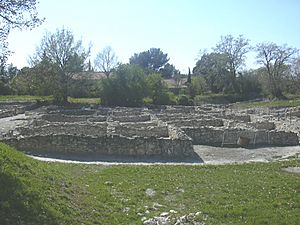Oppidum facts for kids
An oppidum (say: opp-ih-dum) was a type of large, important settlement in ancient Europe. The word comes from Latin and means "enclosed space." Think of it as a big, walled town or city from a very long time ago.
Many oppida were built by the Celts during the Iron Age, especially in a region called Gaul (which is now mostly France). The famous Roman leader Julius Caesar wrote about these settlements when he explored Gaul. He called them oppida because they were often protected by strong walls.
Not all oppida were built on hills like hill forts, but many were. They often had:
- Carefully planned walls and gates to protect the town.
- Lots of space inside for homes and activities.
- A good view of the land around them, which helped with defense.
Oppida were a big step in how towns grew in Europe. They were some of the first large places north of the Mediterranean Sea that felt like real cities. Caesar noticed that different Celtic tribes had several oppida, but some were more important than others. This shows that there was a kind of ranking among them.
Oppida and the Roman Empire
When the Romans took over new lands, they often used the existing oppida to help manage their empire. Many of these oppida eventually became full Roman towns. Sometimes, the Romans even moved the town from a hilltop down to a flatter area nearby.
Famous Oppida Sites
One of the best-preserved oppida is at Enserune in France. People lived there continuously from the 6th century BC all the way until the 1st century. This means it was used for hundreds of years!
Other oppida are now hidden underneath modern cities. For example, the ancient oppidum of Vindobona is now covered by the city of Vienna, the capital of Austria.
Images for kids
-
Reconstructed walls of the Celtic oppidum of Bibracte, France
-
Bibracte oppidum, France, seen from above, 1st century BC
See also
 In Spanish: Oppidum para niños
In Spanish: Oppidum para niños










